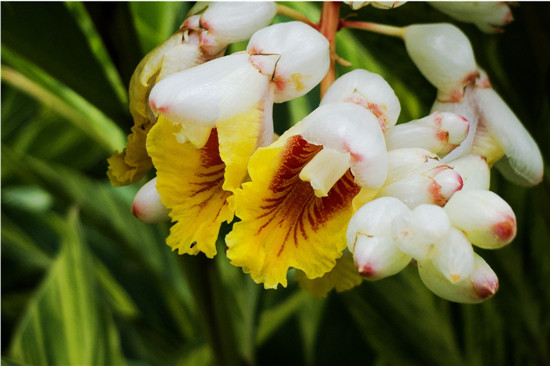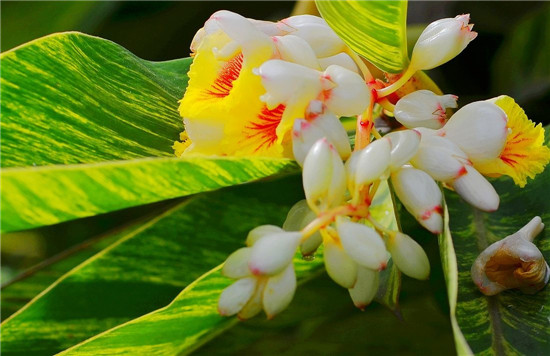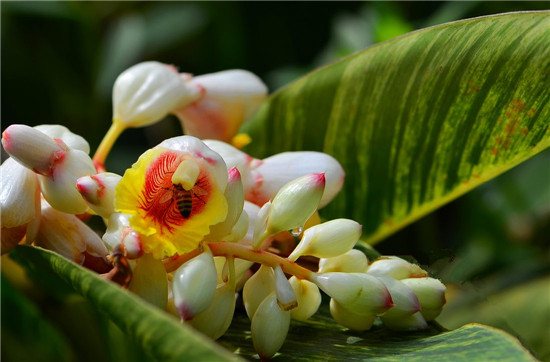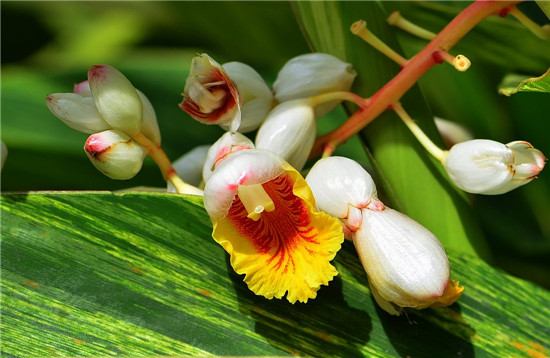How to plant alpinia officinalis how to cultivate alpinia officinalis
Alpinia angustifolia is a kind of excellent foliage plant with beautiful leaves, broad leaves and charming colors. Next, let's take a look at the breeding method of alpinia officinalis.

Zingiberaceae alpinia is a perennial herbaceous foliage plant. Flowers and leaves Yanshan ginger beautiful leaves, June-July flowering, elegant flowers, attractive flowers, potted suitable for hall furnishings. Outdoor cultivation embellishes the courtyard, pool or corner, with a unique style.
The cultivated soil of alpinia angustifolia is loose, drained and well ventilated, which can be planted with domestic peat, mix the peat with water and wait for planting in the cup. The underground rhizome was dug out in spring and summer, the aboveground stem and leaves were cut off, the rhizome was cut and planted, and the plant was preserved in the semi-shade place, and the normal management was restored after the new buds germinated.
Huaye alpinia officinalis is fertilized once a month during the growing period, mainly phosphorus and potassium fertilizer, the basin soil remains moist, the leaves are often sprayed in summer and autumn, and the leaf markings will be more conspicuous in mid-summer. When planted outdoors, choose loose loam with good drainage, see more sunshine in late spring and early summer, slightly shade in midsummer, dig out the rhizome and store it indoors in autumn and winter.

Alpinia angustifolia takes the mother plant out of the flowerpot, shakes off the excess potted soil, separates the root system as much as possible, and splits it into two or more plants with a sharp knife, each with a considerable root system. and its leaves are properly pruned to facilitate survival.
Alpinia angustifolia was put into a pot and then irrigated with root or watered once. Because its root system is greatly damaged and its water absorption capacity is very weak, it takes about 3-4 weeks to recover new roots. Therefore, it is necessary to control watering within 3-4 weeks after ramet to avoid rotting roots, but the transpiration of its leaves is not affected. In order to maintain the water balance of leaves, it is necessary to spray the leaves once or three times a day. Don't fertilize it these days. After the split, also pay attention to the sun is too strong, should be placed in the shade shed for maintenance.

Key points for the maintenance of alpinia officinalis
First, it is not cold-resistant, generally can only withstand the temperature of about 8 ℃, when the temperature drops to about 10 ℃, wrap the plant with paper, and then put on the plastic film pocket, stored in the room can survive the winter. The ground must be planted in a shelter from the sun and can withstand slight frost. The Beginning of Winter can cut off the leaves and cover the roots with hay to avoid severe frost and damage to the roots. In this way, more new buds will sprout from the roots next spring, forming large clusters of plants. In the north, as long as you stay indoors, you can survive the winter safely. Any plant that can keep warm and survive the winter can be watched all the year round.
Second, when the Spring Equinox began, it began to sprout a large number of new buds. Before growing branches and leaves, liquid fertilizer based on nitrogen fertilizer can be applied to promote its rapid development and multiple occurrence. Stop applying nitrogen fertilizer when the new buds are gradually formed. The phosphorus and potassium fertilizer was applied around the Beginning of Summer to promote its bud to blossom. Alpinia angustifolia is a big-leaf plant with large transpiration, so it must be fully watered during its growth.
Third, the method of plant division was used for propagation. The optimum harvest time of cut flowers of alpinia officinalis (Alpiniazerumbet) and the fresh-keeping solution and pretreatment methods for controlling the shedding of flower buds were studied. the results showed that cut flowers of alpinia officinalis were harvested best when the flower branches developed well but the involucral bracts of inflorescence did not fall off, and silver thiosulfate (STS) and Al2 (SO4) 3 could effectively control the shedding of flower buds of alpinia officinalis. 200mg/L8-HQC+5%SUC+5mg/L6-BA pretreatment solution combined with 10 ℃ pre-cooling treatment for 4 h could effectively reduce the abscission rate of cut flower buds of alpinia officinalis.

Family cultivation of alpinia officinalis
Potted, fertilized once a month during the growing period, mainly phosphorus and potash fertilizer, keep moist on the basin, often spray water to the leaves in summer and autumn, put semi-shaded places in midsummer, leaf markings will be more eye-catching, outdoor planting, choose well-drained loose loam, there is more sunshine at the beginning of spring and summer, the roots will be dug out for indoor storage in autumn, cultivated in the south, and the stems and leaves are green all the year round.
Alpinia officinalis cultivated indoors or in the open field in the south has strong tillering ability and grows rapidly. The pot was changed once every 1 ~ 2 years, the leaves were cut off, and the stems and leaves were replanted and trimmed. In open field cultivation, it is often necessary to remove excessive density and cut off broken stems and leaves to keep the plant shape beautiful. After 4 years of cultivation, the underground rhizome should be dug up again, the old thick stem should be removed, and it should be replanted and renewed.
The above is the whole content of how to plant alpinia officinalis and the breeding method of alpinia officinalis. I hope this article can help you. Please continue to follow us.
The above is the whole content of how to plant alpinia officinalis and the breeding method of alpinia officinalis. I hope this article can help you. Please continue to follow us.
Related
- Wuhan Hospital Iron Tree Blooming Result Was Instantly Frightened by the Gardener Master
- Which variety of camellia is the most fragrant and best? Which one do you like best?
- What is the small blue coat, the breeding methods and matters needing attention of the succulent plant
- Dormancy time and maintenance management of succulent plants during dormancy
- Minas succulent how to raise, Minas succulent plant pictures
- What are the varieties of winter succulent plants
- How to raise succulent plants in twelve rolls? let's take a look at some experience of breeding twelve rolls.
- Attention should be paid to water control for succulent plants during dormant period (winter and summer)
- Watering experience of twelve rolls of succulent plants
- Techniques for fertilizing succulent plants. An article will let you know how to fertilize succulent plants.



